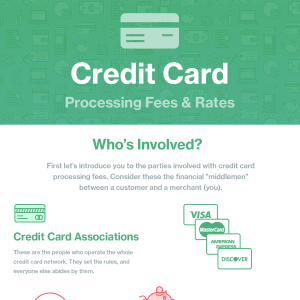Chargebacks are one of the costs of doing business, but you can minimize your risk by communicating well with customers and keeping good records.
Our content reflects the editorial opinions of our experts. While our site makes money through
referral partnerships, we only partner with companies that meet our standards for quality, as outlined in our independent
rating and scoring system.
Dealing with chargebacks can be one of the most frustrating aspects of running a business. Because of their potential impact on your business, preventing chargebacks – and knowing how to deal with them when they happen – is very important. For most merchants, chargebacks will only be an occasional irritant. For others, a high chargeback rate can lead to your business being classified as a high-risk merchant or even having your merchant account frozen or shut down.
While we can’t make your business 100% chargeback-proof, we can help you minimize their frequency and offer some tips on dealing with them when they inevitably occur.
If you’re having trouble with your current merchant account provider, we recommend that you consider switching to one of our favorite credit card processing companies.
Why Small Businesses Need To Prevent Chargebacks
You already know that a chargeback is when a customer bypasses you and goes directly to their issuing bank to get their money back when they’re dissatisfied with a purchase.
Chargebacks can also be initiated when there’s been a clerical error, such as accidentally double-charging for a purchase. Unfortunately, fraud on the part of the customer is also a possibility, and it’s been on the rise in recent years as some consumers have discovered how easy it is to get their money back by filing a chargeback.
Note that chargebacks differ from returns, where the customer seeks to give the goods back to the merchant and get a refund on the money they’ve spent. Returns are relatively straightforward and don’t get the banks involved. While chargebacks typically refer to disputing a credit or debit card transaction, other electronic payment methods, such as ACH payments and echecks, can also be disputed.
Chargebacks represent a double whammy for merchants.
Not only do you have to pay back the funds that were credited to the consumer, but you’ll also be charged a fee by your provider to investigate and resolve the chargeback. You usually won’t get this fee back, even if you prevail in the chargeback investigation. Chargeback fees usually cost $15 – $25 per incident, regardless of the size of the transaction. Almost all providers (Square is a notable exception) will levy a chargeback fee, although a few will refund your chargeback fee if you prevail in the investigation.
When you become involved in a chargeback investigation, the first thing to remember is that chargeback policies are designed as a form of consumer protection. In other words, they’re intended to protect customers from unscrupulous merchants. They aren’t designed to protect you from dishonest customers – something that has become more of an issue in recent years due to increasing rates of chargeback fraud.
Chargeback rules are weighed heavily in favor of the consumer – not the merchant. While we strongly encourage you to defend yourself against any chargeback that you feel is unfair or possibly fraudulent, realize that the odds are stacked against you. In fact, fewer than one in five chargebacks are resolved in favor of the merchant.
12 Essential Tips For How To Avoid Chargebacks
While the chargeback resolution process strongly favors customers, it’s not entirely one-sided. With your odds of prevailing in a chargeback investigation being so low, your best bet is to avoid getting into this situation in the first place. Here are some common-sense tips for preventing chargebacks:
Communicate With Your Customers
Many chargebacks can be easily avoided or rectified if there is open communication between the consumer and the merchant. This works both ways: Consumers should always attempt to resolve the situation through communication with the merchant before resorting to requesting a chargeback. This step is particularly important for eCommerce merchants, who never get to meet their customers in person.
How do you do this? For retail merchants, posting clear refund policies in your store and on your website is a must. Verbally explaining these policies to your customers before finalizing a sale can also be beneficial. Online merchants will have to settle for posting refund information on their websites, but you should make an effort to make it as easy as possible for a customer to find this information. In either case, the goal is to clarify the refund procedure before a customer completes a purchase.
Clearly Describe Your Product Or Service
As a merchant, make sure you give clear descriptions of your products and service policies so that liability is more likely to fall on the consumer for unsatisfactory purchases. Again, this step is especially important for eCommerce merchants, as the customer will have to make a purchasing decision without seeing the product in person.
Offer Excellent Customer Service
In far too many businesses, customer service is an afterthought that doesn’t receive the commitment it deserves. Making it as easy as possible for your customer to contact you by telephone or email will pay dividends in the form of both happier repeat customers and fewer chargebacks. Make it a priority to respond to all inquiries as soon as possible.
Set Clear, Straightforward Return Policies
While no one likes to have to process a return, it’s far less expensive and inconvenient than having to deal with a chargeback. If a consumer is truly unhappy with their purchase, having an easy return policy can drastically lower the likelihood that they will pursue a chargeback. Return policies should be clear and cover any potential situation. At a bare minimum, define how long after purchase the customer has to initiate a return and any restocking fees that may apply.
Confirm The Expiration Date Of All Credit/Debit Cards
You should never accept an expired card. Most credit card terminals will detect an expired card automatically, but you should still manually check the card as a backup. Train your employees to do this as well.
Get The Customer’s Signature For Magstripe-Only Cards
As of 2023, all major credit card associations have eliminated the signature requirement for credit card purchases. However, this change only applies to the use of EMV (chip) cards, which are far more secure than the old magstripe-only cards. While most customers now have chip cards, there are still some magstripe-only cards in circulation, and you’ll still need a signature to process them. Note that Mastercard has already announced plans to phase out the magstripe on its cards altogether. Newly-issued cards will no longer be required to include a magstripe beginning in 2024, and support for magstripes will be completely phased out by 2033.
Provide Your Company’s Contact Information
Card processing errors can easily be fixed by providing consumers with your contact information, whether on the receipt or your website, so they can reach you directly and have the error corrected without initiating a chargeback.
Optimize Your Billing Descriptor
A billing descriptor is simply the name of your business as it will appear on a customer’s bank or credit card statement. Chargebacks often can be a matter of misunderstanding, especially if the consumer is unclear about the transaction details that appear on their statement. Be sure to let the consumer know what business name will appear on their statement. If they cannot recognize the name of your business because of a DBA, the consumer may begin the chargeback process.
Keep Detailed Records Of All Transactions
Chargeback fraud by consumers is becoming more common. It’s all too easy to make a purchase (especially online) and then report it as a fraudulent transaction to the issuing bank. Every year, merchants lose billions of dollars in lost merchandise, transaction reversals, and chargeback fees, all caused by unscrupulous consumers who purchase items and then claim they never did.
On many occasions, the merchant loses these cases because the business lacks simple and clean records.
Ensure your sales receipts are complete and legible so that they can be clearly understood by the consumer as well as act as a valid piece of proof during a chargeback dispute. A clean receipt should be the first step in fighting a chargeback.
Save All Receipts
Time limits for filing chargebacks vary from provider to provider. However, it can be anywhere from 180 days to three years following a transaction. We recommend that merchants retain their receipts and records in an organized fashion, so they can quickly and accurately provide information upon request.
Set Clear Shipping Expectations
Often a consumer will file a chargeback when they pay for an item but have yet to receive it. As a merchant, make sure all merchandise has shipped before depositing a sales receipt. If a customer doesn’t have an item but sees it on their credit card statement, they may decide to request a chargeback.
Every business needs a clear shipping policy that specifies the expected shipping time and accounts for possible delays in delivery.
A chargeback for “services not provided/merchandise not received” can be corrected with shipping details, carrier confirmation, and evidence of delivery, such as a signed delivery receipt. This is often referred to as “proof of delivery.” If the shipping timeframe has not yet passed, and you have clearly stated on your website or receipt to allow a specified number of days for shipping, presenting that information to the investigating bank can stop the chargeback.
If the customer claims they returned the items but never received a credit, let your merchant bank know that you haven’t received the returned merchandise (or the services have not been canceled by the cardholder).
Follow Card Processing Protocols
Chargebacks can usually be prevented by strictly following basic credit/debit card processing protocols. If a card is swiped or dipped and authorization is denied, do not try to run the card a second time. Swiping or dipping multiple times in an effort to authorize a transaction, manually keying in an entry, or calling for credit approval can all result in a chargeback.
- After several years of use, magstripe cards may wear down to the point where your credit card machine can no longer read the information on the card. If this happens and you are forced to manually enter the card data, make an imprint of the embossed card numbers on the back of the receipt. A chargeback done on a manual entry can be lost if there is not an imprint on the receipt.
- If you have to call for authorization, be sure to record the authorization code, date, time, credit representative’s name, and transaction dollar amount authorized.
- Never estimate transaction amounts. This problem is more likely with tip inclusion in restaurants and other industries where tipping is customary.
- To avoid duplicate transactions, ensure they are only entered once and then completely voided if they are incorrect before reprocessing.
- When submitting sales receipts to your bank, ensure that only one copy is submitted. Also, don’t send a copy to two different banks. Multiple copies of sales receipts can result in duplicate billing and (obviously) a chargeback.
- Ensure that your credit card transaction receipts are deposited promptly. Consumers should see the debit on their account within a reasonable time after the sale, not several months later.
- When necessary, use the Address Verification System (AVS). This is particularly important for eCommerce, mail-order, and telephone sales. Note that many providers charge a small fee every time you use AVS. However, it’s a fraction of what a chargeback will cost you.
- For card-not-present transactions, ensure that you collect the CVC2 and CVV2 card verification numbers. This is the three-digit security code on the back of the customer’s card.
How To Fight Chargebacks: The Chargeback Resolution Process
Every chargeback is investigated and resolved following a standardized process, regardless of the issuing bank or credit card association that sponsored the card involved in the dispute. This process consists of the following steps:
- Initial Filing: In almost all cases, the customer must request a refund from the issuing bank to initiate the chargeback resolution process.
- Initial Review: Based upon information provided by the customer (and assuming the customer is telling the truth), the issuing bank will review the circumstances surrounding the disputed transaction and file a reason code to categorize the assumed reason for the chargeback.
- Investigation: The issuing bank investigates the customer’s claims and any other available evidence. It then decides whether the claim is valid. If it is, it issues a credit to the customer and removes the disputed funds from the merchant’s bank account. If, on the other hand, it decides that the claim is not valid, the chargeback is voided, and no further action is taken. Note that this decision is not final.
- Processor Review: The merchant’s processor reviews the chargeback. If the processor has evidence that the chargeback is not valid, it will act on the merchant’s behalf to reject it. Otherwise, it will levy the chargeback fee and pass along all information it has to the merchant.
- Merchant Review: The merchant now has the opportunity to review the chargeback and present any additional evidence that could affect the outcome. Note that this is usually the first time in the chargeback resolution process that you will be informed of the circumstances surrounding the chargeback.
- Re-Presentment: The processor re-presents the chargeback based on any additional evidence offered by the merchant.
- Final Decision: The issuing bank reviews all evidence presented and issues a final decision. If the chargeback is invalidated, funds are returned to the merchant. Most processors, however, will not refund the chargeback investigation fee even in cases where the merchant prevails in this process.
Preventing Chargebacks Is All About Being Proactive
While merchants are probably never going to like chargebacks, they make sense from a public policy perspective. Consumers need to be protected, and as a merchant, remember that you’re often a consumer, too. Chargeback rules encourage merchants to be honest and have fair return policies. They also discourage merchants from selling substandard goods or services. This is particularly important as more and more commerce is conducted online, where the consumer doesn’t have the opportunity to inspect goods physically before making a purchasing decision.
At the same time, chargeback fraud on the part of dishonest consumers is a growing problem. As a consumer protection measure, the existing chargeback system today doesn’t adequately take the possibility of customer-based fraud into account. While the payments industry is working to make it harder for dishonest consumers to get away with so-called “friendly fraud,” there’s still no foolproof solution to this problem.
For now, your best bet is to avoid suffering a chargeback in any way you can. The steps we’ve outlined above will help you minimize the possibility of a chargeback resulting from an error on your part. We also encourage you to keep an open line of communication between your business and your customers. Let them know that they should come to you first before resorting to contacting their credit card issuer for a refund.
While having at least an occasional chargeback is an unavoidable part of doing business, you should be able to minimize the frequency of chargebacks you have to deal with by following the preventative steps we’ve outlined above. With friendly fraud on the rise, many providers are now offering software-based chargeback protection programs to further safeguard your business against chargebacks. In many cases, these programs are a good investment and can lower your overall costs in responding to chargebacks.
Check out the complete guide to chargeback management for information on some of the most popular programs.
Good luck!
FAQs: Preventing Chargebacks
Do chargebacks hurt merchants?
Yes. In addition to the cost of the refund to the consumer, merchants incur restocking and chargeback investigation fees. Dealing with chargebacks also takes time away from running your business, and experiencing too many chargebacks can get your merchant account shut down or converted to a much more expensive high-risk account.
Can you fight a chargeback?
Yes. Merchants can and should respond vigorously to any chargebacks they feel are fraudulent. At the same time, if you know that the error was on your end, it’s better to accept the chargeback and move on.
How many days does a merchant have to dispute a chargeback?
Each credit card association has its own rules for responding to chargebacks, but merchants generally have 45 days from when the chargeback was filed to respond and present their evidence.
How do you win a chargeback?
There is no foolproof way to always prevail in a chargeback investigation. However, submitting a clear, legible receipt and any other relevant documentation as part of your response will give you the best chance of prevailing.
Do customers always win chargebacks?
No. However, chargeback policies are designed primarily to protect consumers, not merchants. Customers generally win around 80% of all chargeback investigations.











